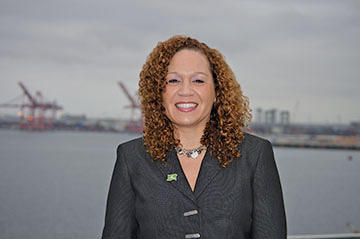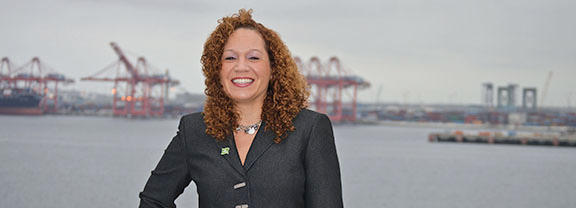With a year and a half under her belt on the Long Beach Board of Harbor Commissioners, Lori Ann Guzmán took over the reins as president of the five-member board this summer from Commissioner Doug Drummond.
As the current director of finance for the City of Huntington Beach and having served in the same capacity for the City of Long Beach, Guzmán keeps a trained eye on the Port of Long Beach’s financial stability, which she recognizes is the firm footing necessary to preserve the strength of the economic engine.

Lori Ann Guzmán is president of the Long Beach Board of Harbor Commissioners. (Photograph by the Business Journal’s Larry Duncan)
Presiding over the first-ever female majority board of harbor commissioners in the port’s history, Guzmán told the Business Journal that she is squarely focused on growing both gender and ethnic diversity within the organization and the international trade industry. She emphasized that as board president she is also determined to strengthen the port’s relationship with the surrounding community and expand upon its environmental efforts.
“It’s an amazing time for me to even be on the commission, and to be president, no less,” Guzmán said. “In our 104-year history, we have never had this many moving parts, this many challenges or this many opportunities.”
The Port of Long Beach is still contending with the root causes of historic levels of congestion that plagued it last year, but recent cargo volume statistics show it has more than recovered from related businesses losses.
“We are really excited about this last quarter because it is a breakthrough quarter; it is unprecedented,” Guzmán said. After three months of record-breaking cargo volumes, the port announced in early October that its third quarter was its best ever, she noted.
“The challenges we faced last year with the congestion, it was almost like the Great Recession where the situation was challenging but it tested everyone’s basic concept of the status quo and what works,” Guzmán said. Although the situation was challenging, she felt that it also created an opportunity to examine areas in which the port could improve.
Key in that process has been placing a renewed emphasis on customer service.
“Customer relations matter and customer service matters, and we can’t rest on our laurels and think that just because of our geography and our location – that we are so uniquely situated geographically [for trade] – that people will just come running back,” Guzmán said. “That’s not the case. The congestion last year was significant, and some cargo was diverted.”
She continued, “The team here, between the commissioners and executive staff, [we] had over 300 meetings with different stakeholders over the last 12 months.” Those stakeholders included beneficial cargo owners, ocean carriers, terminal operators, rail lines, the drayage community, the International Longshore and Warehouse Union and others.
“[We] really came together to say, ‘Come back. We’re open for business and we’ll take good care of you. Customer service matters.’”
To ensure the port maintains its competitive edge, Guzmán said she believes the velocity and reliability of cargo movement through the port must be improved. The port has been collaborating with the Port of Los Angeles and supply chain stakeholders through a Federal Maritime Commission-sanctioned discussion agreement to accomplish this goal, she noted.
Investments in infrastructure also position the port to remain competitive, Guzmán explained. “Our $4 billion capital program is another standout feature for us that makes us a lot more competitive, between the Gerald Desmond Bridge [Replacement] Project, our Middle Harbor [Redevelopment] Project, and also our emphasis on on-dock rail,” she said.
“You can’t be reactive in this industry,” Guzmán said. “By the time you realize you don’t have capacity, it’s too late – much like what’s happening with the Panama Canal and some other ports around the world.”
A project to widen the Panama Canal to accommodate vessels carrying more than 13,500 twenty-foot equivalent units (TEUs) of cargo is nearly complete, but many ocean carrier lines have 18,000 TEU ships and larger on order. “Having that long-term vision and outlook puts you in a better position to be able to plan,” she emphasized.
The Gerald Desmond Bridge and Middle Harbor projects were approved years ago, demonstrating the port’s forward thinking in preparing for the mega ships of the future, Guzmán pointed out.
To ensure that the port remains a strong economic asset, keeping it on solid financial footing is a must, in Guzmán’s view. “It’s not just our port; it’s really the nation’s port,” she said. “So, making sure that we continue to do our part to make sure that it’s financially sustainable over the long term for the benefit of the community, the City of Long Beach, and the nation at large is really important.”

“We really are the leading shining example, the North Star if you will, of environment stewardship.” – Lori Ann Guzmán, President, Long Beach Board Of Harbor Commissioners
The port’s fiscal outlook “is something I care very strongly about because with any asset, if you don’t maintain it from a financial standpoint and you’re not fiscally responsible with it, the asset will eventually deteriorate in some way to the point of non-existence,” she said.
Guzmán said she has a strong relationship with the port’s chief financial officer and other financial staff. “I work with them closely to look at our 10-year forecast and our debt issuances, and making sure that I understand that and feel comfortable with it, especially when you have an unprecedented capital program and you will be issuing additional debt to be able to finance that,” she explained.
“As we move forward to build out our infrastructure to improve the velocity and to be more of a state-of-the-art, cutting-edge port, I am sure that with the plans we have in place we will be able to meet our debt service ratios and operating costs, and still be able to continue to invest,” Guzmán said.
Having harbor commissioners with wide-ranging backgrounds is also key to moving the port forward.
“We are a very passionate bunch. We have diverse backgrounds and are very successful in our fields,” Guzmán said. “I have the natural leaning towards financing, and Commissioner [Tracy] Egoscue has the natural leaning toward the environmental issues,” she explained.
“Commissioner [Rich] Dines works on the docks, so he has hands-on knowledge and experience. And Vice President [Lou Anne] Bynum, she is an expert at economic development and small businesses.” She continued, “And then Commissioner Drummond, [there is] just a remarkable history there with government leadership and the law enforcement background as well. So we are a very talented board with very unique skillsets.”
One of Guzmán’s former mentors once told her, “If we’re all thinking alike, we’re not thinking. We’re missing something. And we may be missing something really big,” she recalled. Having a board of harbor commissioners with differing backgrounds prevents that.
“We have a female majority board now, so I think that helps to echo . . . the importance of having diversity within an organization,” Guzmán said. “It just makes for better, more well-rounded conversation when you have diverse stakeholder groups, whether it is ethnic diversity or gender diversity.
“I feel like there could be more opportunities for women in international trade,” Guzmán reflected. “It is, for certain, a male-dominated industry. That’s why I feel strongly about my role as president in encouraging more women in management level positions across the board in any of our stakeholder groups, and also within the port itself.”
Guzmán pointed out that women make up about 45 percent of the U.S. labor force, but only about 36 percent of the port’s labor force.
“There is a ways to go to get us [on par with] labor market statistics, but I think that we have done an amazing job, even in the last few years, in terms of bringing on additional women in top level positions,” she said, referring to the recruitment efforts of Chief Executive Jon Slangerup. “I can see with his hiring decisions he believes in ethnic diversity, gender diversity. And that is really important to me, personally.” The port outpaces the nation in its percentage of women in management roles, she noted.
On November 17, the Port of Long Beach is hosting its fifth annual Women In Trade Luncheon, part of an initiative aimed at attracting more women to careers at the port and in the trade industry.
“It’s the largest economic engine in the city, and yet there is a real need to improve that communication with the next generation,” Guzmán said. She hopes that in the future the port can forge stronger connections with the Long Beach Unified School District to help educate local students about the port and related careers.
Beyond educational and career initiatives, Guzmán is focused on continuing to grow the port’s ties to the community. “When you’re such a large asset in the community financially, you also have a strong social responsibility to communicate with the community and to tell your message,” she said.
“We want to grow business . . . but we want to do it in a way that’s sensitive and responsive to the needs of the people who will be dealing with the impacts,” she continued. “So getting that message out is important.”
Tied directly to the health of the surrounding communities are the port’s environmental initiatives, such as its Clean Air Action Plan, Clean Trucks Program, and others. While “The Green Port” is the Port of Long Beach’s moniker, Guzmán said more could be done to work towards greater environmental sustainability.
“We really are the leading shining example, the North Star if you will, of environment stewardship,” Guzmán said. “We have that prominence globally, which means that, as a leader and as that North Star, we need to continue to push the envelope just a little bit more.”
The board is focused on updating the Clean Air Action Plan and hopes that efforts among supply chain stakeholders and the state’s environmental agencies to develop a sustainable freight infrastructure plan will further the port’s environmental sustainability as well, Guzmán said.
In the end, President Guzmán said, “We are all very committed to making sure that we’re the best port we can be.”
